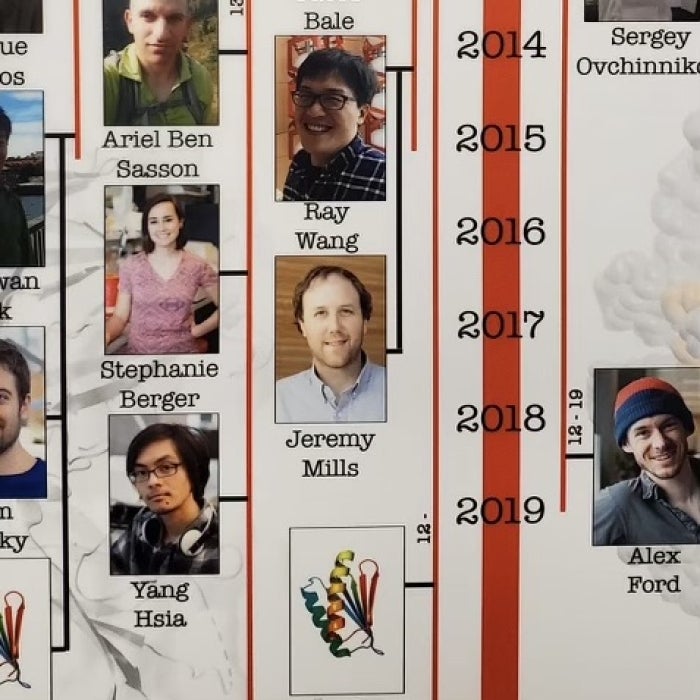A Nobel inspiration: Shaping the future of protein design

Proteins are made of chains of amino acids. In computational protein design, computers are used to predict how changes in these amino acids affect a protein's function, allowing scientists to "design" proteins with specific tasks in mind. Photo courtesy of Depositphotos
When David Baker of the University of Washington was awarded the 2024 Nobel Prize in chemistry for his pioneering work in computational protein design on Oct. 9, the recognition reverberated throughout the scientific community.
For Jeremy Mills, an associate professor in Arizona State University’s School of Molecular Sciences, the news was personal.
As a postdoctoral researcher in Baker’s lab, Mills worked closely with the newly minted Nobel laureate, absorbing lessons and insights that continue to influence his own work in the field today.
At ASU, Mills builds on his experience from Baker’s lab, sharing his own passion with his students and advancing research focused on custom designing new proteins using advanced computational techniques — work that could lead to breakthroughs in treating diseases, developing new enzymes for industry and addressing critical environmental challenges.
“Working in David’s laboratory was a truly unique experience,” said Mills, who also is a faculty member in ASU’s Biodesign Center for Molecular Design and Biomimetics. “Every day, my colleagues and I were doing things that had not only never been done before but were so ambitious that even trying them seemed almost foolish. I truly love the field of protein design, and I hope to get more people as excited about it as I am.”
ASU News spoke with Mills about his current research in the School of Molecular Sciences, his time in Baker’s lab and the future applications of computational protein design.
Question: What was your reaction when you heard about David Baker winning the Nobel Prize alongside Demis Hassabis and John Jumper, and how do you think it will impact the field of computational protein design?
Answer: When I heard that David won the Nobel Prize, I was elated. I’ve been completely enamored with the field of protein design since midway through my graduate education. The ability to manipulate protein structures at the atomic level in computers and then see the implications of your tinkering borne out in experimental results is the most fun thing I can do as a scientist. My hope is that the prize will bring the same excitement for the field that I have to the next generation of scientists.
Q: For people not familiar, how would you describe computational protein design and its potential impact and importance in everyday life?
A: Proteins are like tiny machines in all living organisms that perform essential biological tasks. They are made up of chains of amino acids, and the specific order of these amino acids determines the protein’s shape and function.
In computational protein design, we use computers to predict how changing certain amino acids will affect the protein's function. This allows us to “design” new proteins with specific tasks in mind.
Historically, scientists had to test countless variations of proteins in the lab, but David Baker’s software, called Rosetta, simulates this process on the computer, speeding up the discovery of useful proteins. So far, this technology has led to the creation of new enzymes, protein-based drugs, like a COVID vaccine, and even proteins that can neutralize harmful substances like fentanyl, showing its potential to greatly improve human health.
Q: Can you describe some exciting research projects underway in your lab that connect to this work?
A: In my lab, we use David Baker’s software, Rosetta, to design proteins, but we take it a step further by incorporating amino acids that don’t exist in nature. One project I’m especially excited about involves using a special type of amino acid that can bind to metal ions to create enzymes that rely on metals to function. It’s a tough challenge, but if we succeed, it could lead to the rapid creation of enzymes capable of breaking down harmful proteins, like the spike protein found in the COVID virus.
Q: Looking ahead, what do you see as the most promising developments in protein engineering, and how might your research contribute to that future?
A: I’m most excited about the prospect of designing entirely new enzymes. This has long represented the holy grail of protein engineering and remains one of the more challenging targets for the protein design field. In the last few years, David has made great progress toward this goal using machine learning-enhanced protein design methods that were only recently developed in his laboratory.
While David focuses on building enzymes with natural amino acids, my lab takes a different approach by using amino acids that don’t exist in nature. I believe that our two approaches will truly complement each other and will reveal important insights into how enzymes work, insights we couldn’t get from studying natural proteins alone.
More Science and technology

ASU postdoctoral researcher leads initiative to support graduate student mental health
Olivia Davis had firsthand experience with anxiety and OCD before she entered grad school. Then, during the pandemic and as a result of the growing pressures of the graduate school environment, she…

ASU graduate student researching interplay between family dynamics, ADHD
The symptoms of attention deficit hyperactivity disorder (ADHD) — which include daydreaming, making careless mistakes or taking risks, having a hard time resisting temptation, difficulty getting…

Will this antibiotic work? ASU scientists develop rapid bacterial tests
Bacteria multiply at an astonishing rate, sometimes doubling in number in under four minutes. Imagine a doctor faced with a patient showing severe signs of infection. As they sift through test…

